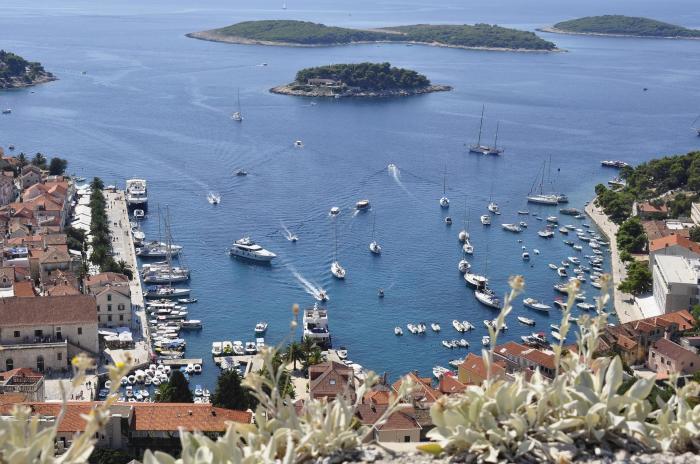
Island facts
Hvar, with a length of 68.2 km, is the longest island in the Adriatic Sea. It belongs to the group of central Dalmatian islands, and with an area of 299.6 km2 (314 km2 with associated islands), it is the fourth largest island in the Adriatic. The highest peak on the island is Sv. Nikola, with a height of 628 m, is the third peak of the Adriatic islands. The western part of the island, with a maximum width of 10.5 km, is much more massive and wider than its eastern part.
Hvar is part of Split-Dalmatia County (Republic of Croatia) and has a population of 10,769. Administratively, it is divided into four parts, from west to east: the town of Hvar, the town of Stari Grad, the municipality of Jelsa and the municipality of Sućuraj.
Throughout its long history, the population has always been engaged in fishing and agriculture. Since 1868, it has begun to engage in organised tourism, which today is the most important source of income for most islanders. The most important agricultural products are wine, olive oil, and lavender oil. Thanks to the record number of sunny hours and clean and unpolluted nature, all agricultural products from the island of Hvar are of the highest quality.
The island's cuisine is healthy, homemade food, especially fresh fish and olive oil. This island is most attractive to tourists because of the untouched nature, numerous picturesque bays and beaches, crystal clear sea, pleasant climate, historical and cultural sights, gastronomic offer, entertainment, quality accommodation, friendly hosts and pleasant and relaxed atmosphere throughout the island.
The island's nickname is “Sunny Hvar.” The Hvar weather station was established in the 1850s, and noting that the average yearly sun hours are over 2700 led to the development of tourism. Visitors started flocking to the island from all over the Austro-Hungary Empire, which in 1860 Hvar was part of. This led to the founding of the first European shareholding company to promote tourism in 1868 on Hvar. It is due time that island sun energy is used by islanders for purposes other than tourism.
The power grid
As most of the Croatian islands are interconnected to the mainland, so is the island of Hvar. The main power supply of the island of Hvar is provided from the transformer 110/35 kV station "Stari Grad", which is connected to the electricity system of the Republic of Croatia 110 kV transmission line Stari Grad - Nerežišća on the island of Brač (62 MVA transmission) and the 110 kV transmission line Stari Grad - Blato on the island of Korčula transmission of 62 MVA). This station has an installed capacity of 2x20 MVA (2x40 MVA), and its position and capacity provide enough electricity for Hvar's 35 kV network. The maximum load achieved in recent years is only 26% of the installed power transformations. Although the amount of energy is seemingly sufficient, problems occur mostly in supplying the central and eastern parts of the island, which are supplied by the 10 kV transmission line Stari Grad - Sucuraj. Through difficult terrain, it passes in a 60 km long line. Power outages are common, as well as extremely large voltage drops resulting from atmospheric discharges or large exposure salts, which ultimately greatly reduce the quality of supply and jeopardise the security of the consumer.
The vision
Including its associated islands, it is planned that the island of Hvar will be self-sustaining in every way, including energy, by 2035. The local community is educated, informed and involved in the island's development . It is considered that it is only possible to achieve a vision of energy self-sufficiency with common efforts, which also leads to reduced CO2 emissions. Through workshops and questionnaires, the locals consider that the island of Hvar is, in every aspect, an island that enables the creation of a utopian archipelago with its potential.

